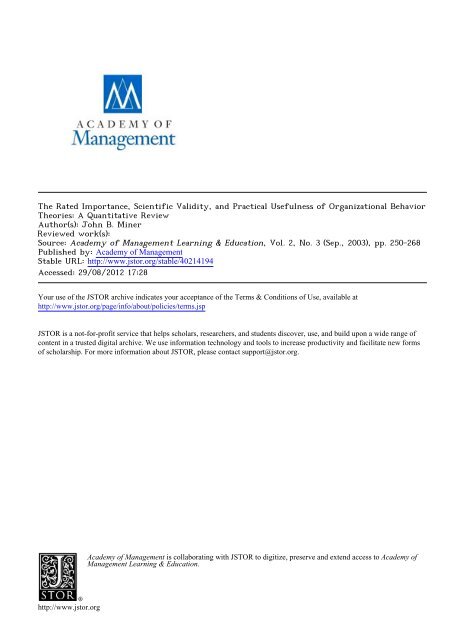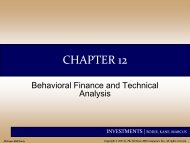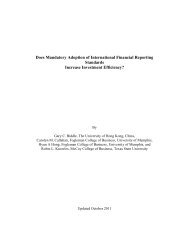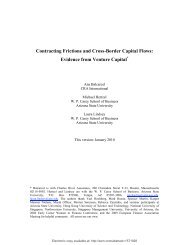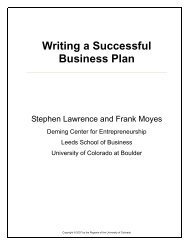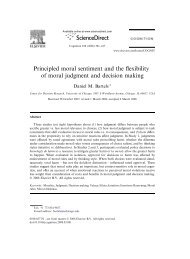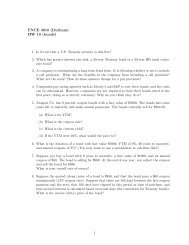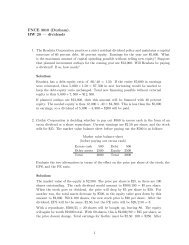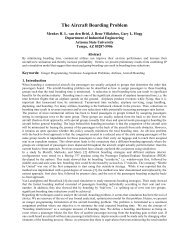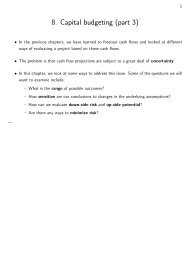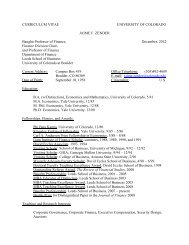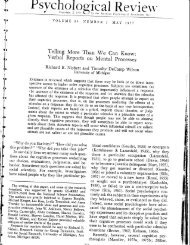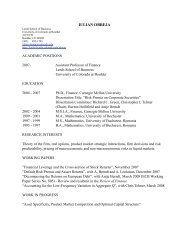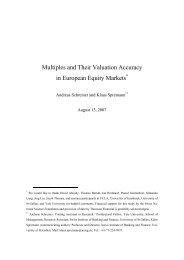The Rated Importance, Scientific Validity, and Practical Usefulness ...
The Rated Importance, Scientific Validity, and Practical Usefulness ...
The Rated Importance, Scientific Validity, and Practical Usefulness ...
Create successful ePaper yourself
Turn your PDF publications into a flip-book with our unique Google optimized e-Paper software.
<strong>The</strong> <strong>Rated</strong> <strong>Importance</strong>, <strong>Scientific</strong> <strong>Validity</strong>, <strong>and</strong> <strong>Practical</strong> <strong>Usefulness</strong> of Organizational Behavior<strong>The</strong>ories: A Quantitative ReviewAuthor(s): John B. MinerReviewed work(s):Source: Academy of Management Learning & Education, Vol. 2, No. 3 (Sep., 2003), pp. 250-268Published by: Academy of ManagementStable URL: http://www.jstor.org/stable/40214194 .Accessed: 29/08/2012 17:28Your use of the JSTOR archive indicates your acceptance of the Terms & Conditions of Use, available at .http://www.jstor.org/page/info/about/policies/terms.jsp.JSTOR is a not-for-profit service that helps scholars, researchers, <strong>and</strong> students discover, use, <strong>and</strong> build upon a wide range ofcontent in a trusted digital archive. We use information technology <strong>and</strong> tools to increase productivity <strong>and</strong> facilitate new formsof scholarship. For more information about JSTOR, please contact support@jstor.org..Academy of Management is collaborating with JSTOR to digitize, preserve <strong>and</strong> extend access to Academy ofManagement Learning & Education.http://www.jstor.org
° Academy of Management Learning <strong>and</strong> Education, 2003, Vol. 2, No. 3. 250-268.<strong>The</strong> <strong>Rated</strong> <strong>Importance</strong>,<strong>Scientific</strong> <strong>Validity</strong>, <strong>and</strong><strong>Practical</strong> <strong>Usefulness</strong>of OrganizationalBehavior <strong>The</strong>ories: AQuantitative ReviewJOHN B. MINER/ analyze rated importance, extent of recognition, validity, <strong>and</strong> usefulness of 73established organizational behavior theories, differentiating between the views of judgeswith expertise in organizational behavior <strong>and</strong> in strategic management. <strong>The</strong> resultsindicate an increasingly mature science with many more positive relationships amongthe variables considered than existed previously. <strong>The</strong> findings have major implicationsfor learning <strong>and</strong> education activities, such as textbook writing <strong>and</strong> organizationalbehavior course design in that they indicate which theorie should be stressed <strong>and</strong> whichshould be given minimal, if any, attention at different levels of the educational process.At various points scientific disciplines need to takestock of their progress <strong>and</strong> use the informationthus marshaled as feedback to readjust their goals<strong>and</strong> approaches. By drawing upon knowledge ofpast successes <strong>and</strong> failures of a discipline, theycan often recast its thrust into the future. Organizationalbehavior is no exception, <strong>and</strong> I attempthere to make a contribution of this kind to the field.Specifically, the objective is to take stock of 73established theories of organizational behavior(broadly defined), <strong>and</strong> to determine from this assessmentwhat implications emerge for the futureof the discipline. I sought the same objective in anearlier evaluation of much the same kind carriedout from 1977-1982 <strong>and</strong> published somewhat later(see Miner, 1984, 1990). In essence, then, this is a20+ year update on the earlier analysis whichtakes into account the growth <strong>and</strong> other changesthat have occurred in organizational science overthe interim, <strong>and</strong> extends that analysis in severalnew directions.Some time ago Kurt Lewin indicated that "nothingis as practical as a good theory" (1945: 129).This statement has been treated as something of adictum (Van de Ven, 1989). However, if "practical"is viewed as meaning that which is useful in anapplied setting to achieve some goal, <strong>and</strong> "goodtheory" refers to theory of a kind that producesvalid scientific knowledge (underst<strong>and</strong>ing, prediction,truth), then Lewin's statement becomes a testablehypothesis. I propose to do so here.A third contribution to which I aspire is to provideinformation on the extent that consensusprevails with regard to organizational behaviortheory, <strong>and</strong> thus the extent to which a solid knowledgebase exists within the field. <strong>The</strong>re appears tobe a widespread belief that the degree of consensusamong knowledgeable scholars that marksany mature science <strong>and</strong> that produces positiveconsequences for members is lacking in organizationalbehavior (Pfeffer, 1993, 1995). Fragmentationcaused by controversy <strong>and</strong> partisan politics aresaid to be rampant <strong>and</strong> are even extolled on occasion(Clegg, Hardy, & Nord, 1996). <strong>The</strong> analysesreported here provide input regarding this issue asof the year 2000.Fourth, I compare data from the past with thecurrent scene. What has changed? Has there beenany improvement? Is organizational behavior movingtoward maturity (or away from it)? How do250
2003 Minei 251comparisons over time contribute to the developmentof m<strong>and</strong>ates for the future?Finally, I hope to provide assistance to thosewho teach organizational behavior courses at anylevel in selecting which theoretical conten to emphasize;in doing this I draw upon findings relatedto all four of the preceding issues.ESTABLISHING THEORIES TO BE STUDIED<strong>The</strong> theories judges were asked to evaluate wereaccumulated in several different ways; I present<strong>and</strong> analyze all 73 in Miner (2002a). In 1984 I evaluateda number of theories where the selectionprocess was guided by a survey of knowledgeablescholars of the time who nominated theories forinclusion. To this list was added an even largergroup of theories which also met the criteria that(1), the author(s) had produced substantial theoreticalwork; (2), this theoretical work is identifiedwith the field of organizational behavior; <strong>and</strong> (3),the theory is recognized as significant within organizationalbehavior. <strong>The</strong> third point was addressedby drawing on various published sources includingBedeian (1992-1998), Pugh <strong>and</strong> Hickson (1993),Pollard (1974, 1978), Wren <strong>and</strong> Greenwood (1998),Tosi (1984), Mathur (1990), <strong>and</strong> Donaldson (1995).Note that four of these sources were written byauthors from outside the United States.<strong>The</strong>se theories may be divided as to content intocategories labeled general (7); motivation <strong>and</strong> perception(16); leadership (17); organizationwide, i.e.,system concepts, bureaucracy related, <strong>and</strong> othersuch (27); <strong>and</strong> decision making (6). <strong>The</strong>y also maybe categorized to represent the various stages inthe historical development of organizational behaviorfrom those that predate the actual creationof the field, all of which are general in nature <strong>and</strong>cover multiple content areas (7); to first-generationtheories, which were initiated in the period fromthe mid-1950s, or in a few cases somewhat earlier,to the initial part of the 1970s (46); to bridgingtheories, defined as having clear ties to earlierfirst-generation theories, but appearing initiallysomewhat later, from 1975 up through the 1980s (7);<strong>and</strong> finally to second-generation theories, whichcame on the scene from the mid-1970s on into the1990s (13). In this connection note that in most instancesit takes roughly 10 years for sufficient researchto emerge to assess a new theory adequately.<strong>The</strong>se 73 theories are listed by name <strong>and</strong>author(s) in Table 1. Of these theories, 17 haveauthors who have substantial ties to countriesother than the United States.ESTABLISHING JUDGES TO ASSESS THETHEORIES<strong>The</strong> sources of the judges (knowledgeable scholars)were essentially the same as those used in theprior analysis - past presidents of the Academy ofManagement, past editors of the Academy of ManagementJournal past editors of the Academy ofManagement Review, <strong>and</strong> editorial (review) boardmembers from both of these publications (in thisinstance for the years 1999 <strong>and</strong> 2000). This processproduced 226 individuals who were contacted bymail, of whom 95 provided usable responses for a42% response rate; this contrasts with a 35% responsein the earlier study (Miner, 1984). Tworounds of mailings were involved, the first roundyielding 67 judges who replied from November,2000 through January, 2001, <strong>and</strong> the second round28 judges who replied during February <strong>and</strong> March,2001.<strong>The</strong> judges ranged in age from 32 to 74 yearswith a mean of 48.1 years. <strong>The</strong> sex breakdown was78% male <strong>and</strong> 22% female. <strong>The</strong>re were 17 who residedoutside the United States in 9 countries. Allappear to have held doctorates. Data were ob-tained on the subject area of the doctorate, as wellas areas of research specialization, teaching specialization,<strong>and</strong> consulting specialization. Fromthis information judges were assigned to groups ashaving primary expertise in either strategic managementor organizational behavior. <strong>The</strong> strategicmanagement group numbered 24, with 67% havingdegrees in that field <strong>and</strong> another 17% in management.<strong>The</strong> 71 organizational behavior specialistshad 49% of their degrees in OB, 21% in psychology(industrial/organizationalsocial), <strong>and</strong> 15% in humanresources or industrial relations. <strong>The</strong>re wassome limited overlap across groups in that 29% ofthe strategic management group indicated someOB activity <strong>and</strong> 13% of the organizational behaviorgroup indicated some strategic activity. Nevertheless,these two groups were clearly distinct; theywere the only distinct groups of any size that couldbe identified. Thus strategic management, in additionto organizational behavior, was studied becausethe data available made it possible to do so.ESTABLISHING KEY VARIABLES TO BEMEASURED<strong>Rated</strong> <strong>Importance</strong> of <strong>The</strong>oriesEach judge was asked to rate each of the 73 theorieson a 7-point scale of importance from low (1) tohigh (7). A fheory was defined as including models,definitional systems, analytical schema, <strong>and</strong> powerfulconstructs. <strong>The</strong> criteria indicated to evaluate
252 Academy of Management Learning <strong>and</strong> EducationSeptemberTABLE 1<strong>The</strong>ories Included in Study Sample <strong>and</strong> <strong>Importance</strong> RatingsMean <strong>Importance</strong> RatingOrganizational% Who Did<strong>The</strong>ories Evaluated (Listed by Generation <strong>and</strong> Content) Total Behavior Major References Not EvaluatePreorganizational Behavior (General)1. Conceptualizations Derived from the Hawthorne Studies 4.51 4.65 Mayo (1933); Roethlisberger & 0(Elton Mayo, Fritz Roethlisberger, William Dickson) Dickson (1939)2. <strong>The</strong> Functions of the Executive Concepts (Chester 4.33 4.41 Barnard (1938) 5Barnard)3. Social Psychological Views of Leadership <strong>and</strong> Change 5.15 5.31 Lewin (1947); Lewin, Lippitt, & 7(Kurt Lewin)White (1939)4. Social Philosophy <strong>and</strong> Prophetic Statements on 3.15 3.28 Follett (1924); Metcalf & 25Management (Mary Parker Follett)Urwick (1940)5. <strong>The</strong>ory of Bureaucracy (Max Weber) 5.74 5.90 Weber (1947, 1968) 26. General <strong>and</strong> Industrial Management Formulations 3.48 3.73 Fayol (1949) 13(Henri Fayol)7. <strong>Scientific</strong> Management Formulations (Frederick Taylor) 4.47 4.63 Taylor (1903, 1911) 2First Generation <strong>The</strong>ories (Motivation)8. Need Hierarchy <strong>The</strong>ory (Abraham Maslow) 4.14 4.14 Maslow (1954, 1962) 29. Existence, Relatedness, <strong>and</strong> Growth <strong>The</strong>ory (Clayton 3.41 3.58 Alderfer (1972) 15Alderfer)10. Achievement Motivation <strong>The</strong>ory (David McClell<strong>and</strong>) 4.88 5.15 McClell<strong>and</strong> (1961, 1975) 511. Psychoanalytic <strong>The</strong>ory Applied to Organizations (Harry 2.75 2.84 Levinson (1964, 1973) 23Levinson)12. Motivation Hygiene <strong>The</strong>ory (Frederick Herzberg) 3.73 3.81 Herzberg, Mausner, & 5Snyderman (1959); Herzberg(1966, 1976)13. Job Characteristics <strong>The</strong>ory (Richard Hackman, Edward 5.28 5.61 Hackman & Lawler (1971); 5Lawler, Greg Oldham) Hackman & Oldham (1980)14. Expectancy <strong>The</strong>ory- Work <strong>and</strong> Motivation (Victor Vroom) 5.62 5.96 Vroom (1964) 315. Expectancy <strong>The</strong>ory- Managerial Attitudes <strong>and</strong> 5.23 5.41 Porter & Lawler (1968); Lawler 1Performance (Lyman Porter, Edward Lawler) (1973)16. Cognitive Evaluation <strong>The</strong>ory (Edward Deci, Richard 4.08 4.27 Deci (1975); Deci & Ryan (1985) 25Ryan); A bridging theory17. Operant Behavior <strong>and</strong> Reinforcement <strong>The</strong>ory (Clay 4.07 4.25 Hamner (1974a, 1974b) 12Hamner)18. Organizational Behavior Modification (Fred Luthans, 4.01 4.31 Luthans & Kreitner (1973, 1975, 13Robert Kreitner) 1985)19. Equity <strong>The</strong>ory (Stacy Adams) 5.57 5.93 Adams (1963, 1965) 620. Goal-Setting <strong>The</strong>ory (Edwin Locke, Gary Latham) 5.56 5.97 Locke (1968, 1970); Locke & 4Latham (1990)21. Role Motivation <strong>The</strong>ory (John Miner) 3.99 4.05 Miner (1965, 1993) 25First Generation <strong>The</strong>ories (Leadership)22. <strong>The</strong>ory X <strong>and</strong> <strong>The</strong>ory Y (Douglas McGregor) 4.21 4.39 McGregor (1960, 1967) 123. Consideration <strong>and</strong> Initiating Structure (John Hemphill, 4.38 4.60 Stogdill & Coons (1957); 17Ralph Stogdill, Carroll Shartle) Shartle (1979)24. Managerial Grid <strong>The</strong>ory of Leadership (Robert Blake, 3.06 2.98 Blake & Mouton (1964); Blake 15Jane Mouton) & McCanse (1991)25. Situational Leadership <strong>The</strong>ory (Paul Hersey, Kenneth 3.26 3.28 Hersey & Blanchard (1969) 5Blanchard)26. Path-Goal Relationship <strong>The</strong>ory (Martin Evans) 3.99 4.11 Evans (1970, 1974) 1927. Path-Goal <strong>The</strong>ory of Leader Effectiveness (Robert House) 4.35 4.58 House (1971); House & 7Mitchell (1974)28. Leadership Pattern Choice <strong>The</strong>ory (Robert Tannenbaum, 2.93 3.02 Tannenbaum & Schmidt (1958) 37Warren Schmidt)29. Normative Decision Process <strong>The</strong>ory (Victor Vroom, Philip 4.26 4.44 Vroom & Yetton (1973); Vroom 6Yetton, Arthur Jago) & Jago (1988)30. Influence Power Continuum <strong>The</strong>ory (Frank Heller) 2.54 2.71 Heller (1971); Heller & Wilpert 47(1981)31. Contingency <strong>The</strong>ory of Leadership (Fred Fiedler) 4.21 4.33 Fiedler (1967); Fiedler & 5Chemers (1974)(table continues)
2003 Miner 255who did not evaluate each theory. Further treatmentof this failure-to-rate factor occurs in Appendix A.Clearly the ratings do discriminate well amongthe various theories. But do they discriminate inthe same manner as the nominations used in theearlier study? This is an empirical question thatcan best be answered by correlating the frequencyof nomination for the 34 theories considered in 1977with the mean rating given by the organizationalbehavior judges in the current study to the sametheories. Few judges with a strategic managementspecialization were included in the early group,<strong>and</strong> accordingly, this is the appropriate comparison.<strong>The</strong> correlation is a highly significant .49**.Further evidence on the reliability of the importanceratings comes from the correlation of themean of the first round ratings of each theory (thefirst 67 judges) with the mean for the second roundsubjects (the last 28). This test-retest value acrossroughly 10 weeks is .92**.Estimated <strong>Scientific</strong> <strong>Validity</strong> <strong>and</strong> <strong>Usefulness</strong> inPracticeI rated estimated scientific validity on a 5-pointscale intended to indicate whether "good theory/'<strong>and</strong> thus improved underst<strong>and</strong>ing <strong>and</strong> predictionhad been attained. <strong>The</strong> extent of logical consistency<strong>and</strong> other criteria of "good theory" were invokedhere (see Miner, 2002a), but the key considerationwas the extent to which true research testsof the theory had indeed been carried out, <strong>and</strong> ifthey had, whether they supported the theory. Detailson these ratings are given in Appendix B, Ialso made estimated usefulness ratings on a5-point scale with the objective of testing Lewin'shypothesis. Details on these ratings are given inAppendix C. Further thoughts on the measurementof both validity <strong>and</strong> usefulness appear in AppendixD.ESTABLISHING THAT THE GROUP OF JUDGES ISREPRESENTATIVEEvidence on the probability of nonresponse bias insurveys such as this (where 58% did not respond)may be obtained by comparing the responses on thestudy variables related to individuals of the firstroundrespondents (numbering 67) with those of thesecond-round respondents (numbering 28). <strong>The</strong>se arethe samples used in the test-retest analysis. If differencesare minimal, it is also likely that no differenceswould be found comparing the respondents <strong>and</strong> nonrespondents.If differences are found from Round 1 toRound 2, this trend should be perpetuated into thenonrespondent group, <strong>and</strong> the representativeness ofthe respondent group of judges comes into seriousquestion (Rogelberg& Luong, 1998).Comparisons between the first- <strong>and</strong> secondroundrespondents were made for the mean importanceratings for each theory; the frequency of failureto rate for each theory; for the mean overallimportance rating given by the individual; theproportion of strategic management versus organizationalbehavior respondents; the proportion offirst-generation (50 years or older) versus secondgeneration(under 50 years) respondents; <strong>and</strong> forthe proportion of respondents who proposed additionaltheories beyond the base 73 when given achance to do so versus those who did not.Of these 150 comparisons between Round 1 <strong>and</strong>Round 2, six yielded significant results, all at p
256 Academy of Management Learning <strong>and</strong> EducationSeptemberof appropriate, organizational behavior theories,three emerge with more than two nominations; allwith six nominations, almost exclusively noted byorganizational behavior judges, <strong>and</strong> typicallygiven high ratings. <strong>The</strong>se three theories are labeledorganizational justice, network, <strong>and</strong> identity,but with little consistency as to the authors specified.No other theories have any meaningful numbers,<strong>and</strong> these three receive nominations fromonly 6% of the judges; 8% of the organizationalbehavior group. On this evidence it seems appropriateto conclude that the original 73 theories representa reasonably complete listing. Note alsothat nominations by judges from outside theUnited States unearthed few new theories of aninternational nature <strong>and</strong> did nothing to changethis conclusion.DIFFERENCES BETWEEN GROUPS OF JUDGESStrategic Management vs. OrganizationalBehaviorAt various points in the preceding discussion thestrategic management- organizational behaviordifferential among judges has come up. However,Table 1 indicates the issue most forcefully: If onecompares the mean importance ratings for the totalgroup of judges with those for the organizationalbehavior group only, certain patterns becomemanifest. With only a few exceptions (theorynumbers 8, 24, <strong>and</strong> 52), the importance ratings forthe total group are consistently lower than thosefor organizational behavior through all first-generationtheories until the organizational decisionmakingtheories are reached. Within this latter setof first-generation theories, however, the patternshifts so that the total means are more often thannot higher. Among the second-generation theoriesof motivation <strong>and</strong> leadership the balance movesback to favor the organizational behavior judges,but this does not hold true for the concepts of organization<strong>and</strong> decision-making theories; there thetotal group means are consistently higher.11 <strong>The</strong> above is only a rough analysis. What is different about thetotal group data is that it contains the strategic managementjudges; thus, to really underst<strong>and</strong> what is happening a comparisonneeds to be made between the strategic management <strong>and</strong>the organizational behavior groups. <strong>The</strong> results of such a comparisonindicate that there are 17 instances where the organizationalbehavior means are higher at p < .01, <strong>and</strong> another 7 atp < .05; differences atp < .10 were calculated as well, <strong>and</strong> thereare 10 of these. In contrast only one strategic managementmean is higher <strong>and</strong> that is for the Cyert <strong>and</strong> March behavioraltheory of the firm, a theory with a strong affinity with economics<strong>and</strong> an economist as its primary author. <strong>The</strong> mean of meansTaking all the evidence <strong>and</strong> the logical facts ofthe situation into account, it seemed best to concentrateon the organizational behavior group ofjudges as being the truly knowledgeable scholarshere, <strong>and</strong> it is their data that are used in the followinganalyses. Strategic management, with itsclose affiliation with economics, is apparently adistinct entity as opposed to organizational behavior(see Miner 2002a, for a discussion of the issuesinvolved here). Accordingly, one might expect thatwere strategic management theories under consideration,the same tendencies to fail to rate <strong>and</strong> torate lower would appear among organizational behaviorjudges. A by-product of this analysis is thestrong recommendation that publications be evaluated(peer reviewed) only by those whose disciplinaryorientations fit the material; otherwise, thepossibility of rejecting manuscripts which make asubstantial contribution is high.First- vs. Second-GenerationIn the same ways that strategic management <strong>and</strong>organizational behavior judges were expected todiffer, a similar differential was anticipated asbetween first-generation (50 <strong>and</strong> over) <strong>and</strong> secondgeneration(under 50) judges. Specifically, firstgenerationjudges were believed likely to rate second-generationtheories lower <strong>and</strong> to fail to ratethem more frequently; the same tendencies shouldexist when second-generation judges rated first-across all theories is 3.80 for the strategic management group<strong>and</strong> 4.40 for the organizational behavior judges (t = 9.12**).Clearly the strategic management raters give lower scores tomost organizational behavior theories. <strong>The</strong> pattern noted forTable 1 is once again manifest.Data were also obtained on the failure-to-rate factor. Onemight expect that organizational behavior judges would ratemore of their own theories <strong>and</strong> strategic management judgeswould feel less capable of making these ratings of theoriesoutside their field. Indeed that is what happens. In 28 cases theorganizational behavior raters evaluate the theory significantlymore frequently; the reverse occurs only twice. Although usuallywith a slightly lower proportion of significant results, thesame pattern of findings across generations <strong>and</strong> content areasnoted for the mean ratings is found for number of ratings (orfailure to rate) as well. <strong>The</strong> strategic management group feelless able to rate most of these organizational behavior theories,except for those dealing with decision-making <strong>and</strong> secondgenerationtheories of an organizationwide nature.One result of the pattern noted is that while 20 theories earna really good rating (a score of 5.0 or higher) from the organizationalbehavior judges, only 10 do so when the strategicmanagement judges are involved. Furthermore,theorie sorated by the strategic management group are without exceptionof a decision-making or organizationwide nature; the good theoriesas rated by the organizational behavior group are morebalanced, <strong>and</strong> include a number of microformulations.
2003 Miner 257generation theories.2 1 discuss the rationale behindthis generational differentiation in Miner (2002a).This analysis does not overlap with the previousone since the relationship involved was not closeto being significant (x2 = 2.63, ns; df = 1).From the evidence only 7 of the 146 comparisonswere significant at the .05 level or better. All fittheoretical expectations, but the numbers involvedare not above chance levels. Certainly there is nobasis here for choosing one set of ratings overanother, as was the case in choosing the organizationalbehavior judges over those of a strategicmanagement nature; the differentiation in terms ofthe generation of the group doing the judging isnot that strong.RELATIONSHIPS AMONG VARIABLES<strong>The</strong> analyses that follow are modeled after Miner(1984), although the results are far from being thesame.<strong>Importance</strong> <strong>and</strong> <strong>Validity</strong>Whereas previously there was no evidence of anyrelationship between importance <strong>and</strong> validity,now such a relationship is apparent, although thechi-square reaches only thep < .10 level (see Table2). When, however, the full range of values arebroughto the analysis, the correlation with importanceemerges as .44**. Thus, we now have evidencethat the two are significantly related; it appearsthat a real change has occurred in thisregard.<strong>Importance</strong> <strong>and</strong> <strong>Usefulness</strong><strong>The</strong> organizational behavior ratings of importanceexhibit a significant relationship to estimated usefulnessin practice (see Table 3) - not strong, but areal improvement over what was indicated in theTABLE 2Estimated <strong>Scientific</strong> <strong>Validity</strong> in Relation to MeanOrganizational Behavior <strong>Importance</strong> RatingOrganizational Behavior <strong>Importance</strong> RatingEstimated<strong>Scientific</strong> Low Medium High<strong>Validity</strong> (2.71-3.99) (4.00-4.99) (5.00-5.97)High (4 & 5) 3 11 11Mixed (3) 9 9 6Low(l&2) 10 11 3X2 = 9.14; p < .10;d/ = 4.Miner (1984) report. Yet the correlation using thefull range of variables is only .17 (p = .14), stillbetter than the p value reported previously, butlacking significance. It appears overall that theusefulness factor does contribute to the importanceratings, <strong>and</strong> certainly this relationship has improvedover the years, but it is still not strong.<strong>Validity</strong> <strong>and</strong> <strong>Usefulness</strong>Although the Lewin hypothesis was not supportedin the Miner (1984) analysis, it is now. Perhapswhat is needed to confirm an hypothesis of thistype is a more mature science. <strong>The</strong> chi-squarevalue in Table 4 is significant at p < .01 <strong>and</strong> thecorrelation obtained is .32**.<strong>The</strong>re are 18 theories that score higher on usefulnessthan on validity. In these cases the applicationsappear to have detached themselves fromthe underlying theory, developing a life of theirown, presumably through a process of trial <strong>and</strong>error (Weick, 1987). This process appears to be particularlycharacteristic of theories having a tie toorganization development in some form. Of the 18theories involved, 13 have such a tie. Also 3 moreare of a pre-OB nature, where practical applica-2 Data comparing mean importance ratings by the age-basedgeneration of the raters in fact yielded only one significantdifference (at p < .05); a second-generation theory which wasrated higher by the second-generation raters. In two instancesthe ratings of first-generation theories by first-generation ratersgave evidence of a tendency toward being significantly higher,but only at p < .10. In spite of this dearth of results the firstgenerationmean of 4.32 was above the second-generationmean of 4.23 (t = 2.79**), presumably because there were morefirst-generation theories <strong>and</strong> because the ratings of the twogenerations were highly correlated (r = .94). Insofar as thenumber of ratings is concerned, the picture is somewhat moredifferentiated, all involving pre-OB or first-generation theoriesthat were rated more frequently by first-generation (older)judges. <strong>The</strong>re were six such instances at p < .05 or better.TABLE 3Estimated <strong>Usefulness</strong> in Application inRelation to Mean Organizational Behavior<strong>Importance</strong> RatingOrganizational Behavior <strong>Importance</strong> Rating~~Estimated<strong>Usefulness</strong> in Low Medium HighApplication (2.71-3.99) (4.00-4.99) (5.00-5.97)High (4 & 5) 0 3 7Questionable (3) 10 14 5Low (1 & 2) 12 14 8/ = 12.26; p < .05; df = 4.
258 Academy of Management Learning <strong>and</strong> EducationSeptemberTABLE 4Relationship Between Estimated <strong>Usefulness</strong> in Application <strong>and</strong> Estimated <strong>Scientific</strong> <strong>Validity</strong>Estimated <strong>Scientific</strong> <strong>Validity</strong>Estimated <strong>Usefulness</strong>in Application Low (1 & 2) Mixed (3) High (4 & 5)High (4 & 5) (N = 0) (N = 2) (N = 8)38. Trist & Emery 3. Lewin43. Lawrence & Lorsch 10. McClell<strong>and</strong>13. Hackman et al.18. Luthans & Kreitner20. Locke & Latham21. Miner29. Vroom et al. (Normative)66. BassQuestionable (3) (N = 12)1. Mayo et al.(N = 6)11. Levinson(N = 11)5. Weber6. Fayol 31. Fiedler (Contingency) 14. Vroom (Expectancy)7. Taylor 47. V. Thompson 15. Porter & Lawler12. Herzberg 49. Argyris (Congruence)17. Hamner22. McGregor 55. Golembiewski 19. Adams30. Heller 64. Kerr 33. Graen34. Likert 44. Pugh et al.50. Argyris (Learning)46. Blau51. Bennis 68. Pfeffer & Salancik52. Blake & Mouton (OD)70. Meyer & Scott53. Schein (OD) 73. Beach & Mitchell54. Schein (Culture)Low (1& 2) (N = 12) (N = 16) (N = 6)2. Barnard 9. Alderfer 35. A. Tannenbaum4. Follett 16. Deci & Ryan 56. Simon & March8. Maslow 26. Evans 62. Mitchell & Green23. Hemphill 27. House (Path Goal) 63. Lord & MaherX>= 16.90; p
2003 Miner 259TABLE 5<strong>The</strong> <strong>Validity</strong>-<strong>Usefulness</strong> Matrix in Terms of Areas of <strong>The</strong>ory FormulationEstimated <strong>Scientific</strong> <strong>Validity</strong>Estimated <strong>Usefulness</strong> in Application Low (1 & 2) Mixed (3) High (4 & 5)High (4 & 5)Questionable (3)Low (1 & 2)Systems (38, 43) Motivation (10, 13, 18, 20, 21)Leadership (29, 66)General-Motivation (3)Bureaucracy (50, 51, 52, 53, 54) Bureaucracy (47, 49, 55) Motivation (14, 15, 17, 19)General (1, 6, 7) Leadership (31, 64) Bureaucracy (44, 46)Leadership (22, 30) Motivation (11) Organization (68, 70)Motivation (12) General-Bureaucracy (5)Systems (34) Leadership (33)Decision Making (73)Leadership (23, 24, 25, 28) Leadership (26, 27, 32, 67) Leadership (63, 65)Systems (40, 41, 42) Motivation (9, 16, 61) Motivation (62)General (2, 4)Systems (36, 37, 39) Systems (35)Decision Making (59, 60) Bureaucracy (45, 48) Decision Making (56)Motivation (8) Decision Making (57, 58) Organization (71)Organization (69, 72)Areas of <strong>The</strong>ory Formulation<strong>Validity</strong>-<strong>Usefulness</strong> Other Than Motivation Motivation(4&5, 4&5M3, 4&5H4&5, 3) 11 10Other combinations 45 7/ = 9.72; p < .01; df = 1.exp<strong>and</strong>ed considerably, even though the motivationalfactor continues to add numbers. Since inthe Miner (1984) study, motivation theories clearlydominated this analysis, holding all of the positionsin the high- high category <strong>and</strong> yielding avery significant chi-square, the significance of thisfinding was tested once again using the more recentdata. <strong>The</strong> results at the bottom of Table 5indicate a similar situation in 2000-2001. Motivationcontinues to hold a highly significant position,even though forced to share its dominance withtheories of other kinds. If one wishes to create ahighly valid theory, which is also constructed withthe purpose of enhanced usefulness in practice inmind, it would be best to look to motivation theories,often with a more limited domain, for an appropriatemodel.<strong>The</strong> <strong>Validity</strong>-<strong>Usefulness</strong> Matrix <strong>and</strong> ProfessionalDegree SourceA differentype of overlay for Table 4 may beobtained by entering into the matrix the departmentor program from which the highest professionaldegree of the theorist(s) was obtained.When there are multiple authors, the predominantdiscipline among them is used; thus, the number ofentries equals the number of theories. <strong>The</strong> mostfrequent disciplinary origin among the theories ispsychology with 52%; second is sociology with 12%,followed by organizational behavior at 10% <strong>and</strong>political science at 8%. No other discipline extendsbeyond 4%, although there are a number of fieldsrepresented.<strong>The</strong> Miner (1984) findings using this matrix indicateda highly significant dominance of psychologyamong the various disciplines represented. Infact psychology held almost all of the top spots.However, this is no longer true in 2000-2001, <strong>and</strong>many more theories set forth by psychologists arefurther down in the validity- usefulness matrix.<strong>The</strong> result is that psychology no longer occupies asignificantly strong position (y2 = 2.57, p < .20, df =1). I suspect that this represents a trend into thefuture, <strong>and</strong> that psychology's hold on theoreticaldominance in the field will continue to shrink.Implications for Teaching <strong>and</strong> Learning:UndergraduatesGiven this assessment of the current state of theoryin organizational behavior, <strong>and</strong> drawing upon thedata of Table 1, it is possible to specify somethingabout the implications for course development. Istart with my suggestions for what should be emphasizedin undergraduate courses, where in my
260 Academy of Management Learning <strong>and</strong> EducationSeptemberview we should stress what the field considers to related views, to the more recent positionsuch asbe important, <strong>and</strong> cease to give equal billing to neoinstitutional theory. Across the 27 such theoriestheories which used to be considered important (28 if one includes Weber himself) the mean impor-(but are not now) or never were evaluated very tance rating is 4.38 (4.43 with Weber); 7 achievepositively. <strong>The</strong>se suggestions are broken down by values of 5.00 or above (8 with Weber). Severalcontent areas <strong>and</strong> hold both for a general course in organization development theories have declinedorganizational behavior <strong>and</strong> for more specialized in importance, but two others remain at the topcourses in the various subject areas.level: Trist <strong>and</strong> Emery's sociotechnical theory, <strong>and</strong>Lawrence <strong>and</strong> Lorsch's contingency theory of organ-Motivationizations. Both of the latter are(<strong>and</strong> Perception)systems theories aswell, as are the Katz <strong>and</strong> Kahn theory, JamesMotivation theory has not only exhibited consider- Thompson's theory, <strong>and</strong> the Burns <strong>and</strong> Stalkerable validity <strong>and</strong> usefulness over the years, but view of mechanistic <strong>and</strong> organic systems. Alalsoit generates a mean importance rating of 4.59. though these theories have held positions in theCertainly motivation, <strong>and</strong> personality theory more over-5.00 category, other systems theories, such asbroadly, are not engaged in a "great disappearing Likert's systems 1 to 4 <strong>and</strong> Woodward's technologact"as some have claimed (Nord& Fox, 1996). In ical determinism, have declined sharply.fact 6 of the 16 such theories are rated at 5.00 or Interestingly, none of the bureaucracy-relatedabove in importance. A number of these latter the- views (other than that of Weber) achieve the topories have increased in importance over the past category on importance, although Schein's theory20 years including McClell<strong>and</strong>'s achievement mo- of culture <strong>and</strong> leadership comes close. <strong>The</strong> grouptivation theory, Hackman <strong>and</strong> Oldham's job char- of theories with 5.00 or better importance ratings isacteristics theory, Adams's equity theory, <strong>and</strong> in rounded out with Pfeffer <strong>and</strong> Salancik's resourceparticular Locke's goal-setting theory. <strong>The</strong> de- dependence theory <strong>and</strong> Powell <strong>and</strong> DiMaggio'sclines have been primarily in some of the more version of neoinstitutional theory. Indeed recenthumanistic theories. All the above, plus the Vroom institutional approaches seem to have moved be<strong>and</strong>Porter <strong>and</strong> Lawler versions of expectancy the- yond the "neo" stage already (Dacin, Goodstein, &ory, deserve detailed exposition, in textbooks <strong>and</strong> Scott, 2002). This is an important area to stress.in class.Whether systems theory, which has probablypassed through the period of its greatest popular-Leadershipity, will continue to hold its current high importancerating remains something of a question.Leadership theory is in ferment at the presentime, However, the continuing thrust of organization deprobablybecause there are so few dominant posi- velopment practice will almost certainly drive ations. <strong>The</strong> mean importance rating is 4.00 among reemergence of theory building in that area, perthe17 theories, <strong>and</strong> only Bass's transformational haps working from the frameworks provided bytheory is rated above 5.00. <strong>The</strong> latter is closely sociotechnical theory <strong>and</strong> Schein's theory of organfollowedby House's charismatic theory <strong>and</strong> izational culture. This remains a significant sub-Graen's leader member exchange theory, which ject area to teach, one with considerable practicalhas moved up substantially in importance over the relevance.years. Yet the decline of path-goal theory in itsvarious forms <strong>and</strong> of Fiedler's theorizing has leftsomething of a void in the leadership area. Per-Decision Makinghaps the best way to deal with the lack of impor- <strong>The</strong>re are only six entries on our list of organizatantleadership theories is to combine motivational tional decision-making theories, but they are im<strong>and</strong>leadership content under a "micro" umbrella. pressive. <strong>The</strong> mean importance rating is 4.98, <strong>and</strong> 4<strong>The</strong>re are, in fact, some new theories, such as the theories are rated at 5.00 or above. <strong>The</strong>se four areMiner (2002b) extension of role motivation theory the work in the 1940s <strong>and</strong> 1950s of Simon <strong>and</strong>into the leadership domain, that bridge these two March, the Cyert <strong>and</strong> March behavioral theory ofsubject areas.the firm, March's views on organizational learning,<strong>and</strong> Weick's theories of organizing <strong>and</strong> sense mak-Organizationsing. <strong>The</strong>ories in this area are probably not giventhe attention in undergraduate teaching that theyMacrotheories of organizational structuring <strong>and</strong> should be. My suggestion is to combine them withfunctioning cover a wide range from organization the macrotheories of organization, thus givingdevelopment to systems concepts, to bureaucracy- them greater visibility.
2003 Miner 261Implications for Teaching at the Masters(MBA) LevelMuch of what I have said above holds at the masterslevel as well, especially for general <strong>and</strong> executiveMBA courses in organizational behavior. Inaddition, a historical perspective should be incorporatednot because these concepts are currentlyof great value but because they indicate the multidisciplinaryorigins of organizational behavior<strong>and</strong> point up the need for the scientific base thatultimately emerged. This would require incorporatingthe views inherent in the seven preorganizationalbehavior perspectives in Table 1# especiallythose of Lewin <strong>and</strong> Weber, which continue toexert an influence today.Another issue here involves the teaching of applications.Masters-level students need to underst<strong>and</strong>the applications to practice that organizationalbehavior's theories have generated, <strong>and</strong>they need to underst<strong>and</strong> them in depth. In fact, Ihave in mind to write a book on this topic, simplyto provide a synopsis of material that is not adequatelyemphasized in curren textbooks. Such abook would draw upon the implications for practiceof the 27 theories in the four upper right cells ofTable 4. It would not deal with the 34 theorieshaving little usefulness because these theories eitherlack specific applications or have applicationsthat have been discredited by research; norwould it introduce the 12 additional theories withlow validity because some degree of validity isnecessary to generate a truly useful application (ina scientific sense).I am well aware that many of the theories that Ihave excluded above continue to have considerableappeal for textbook writers, for organizationalbehavior practitioners, <strong>and</strong> for practicing managers,especially certain of the theories listed in thelow-low cell of Table 4. In part this is a function ofinstitutionalization;part it is a consequence ofthe continuing, but declining appeal of a humanisticethic; in part it is a carryover from organizationalbehavior's successes of the past. But this is adifferent time with new theories <strong>and</strong> new research,<strong>and</strong> consequently, with new underst<strong>and</strong>ings. If wecontinue to have faith in science <strong>and</strong> its products,then these anachronisms will eventually take careof themselves. One way that this might happen isthat certain of the excluded theories would come togenerate supportive research on both their propositions<strong>and</strong> their applications of a kind that simplydoes not exist at present (<strong>and</strong> thus relegates themto the excluded cells of Table 4).Implications for Teaching at the Doctoral(PhD) LevelAs one moves to more specialized courses primarilyat the doctoral level, it becomes importantoteach not only good theory, but also not-so-goodtheory. Now the goal increasingly becomes one ofcritiquing theories to teach skills in evaluating anynew theory that comes on the scene, <strong>and</strong> perhapseven develop the ability to create new theory. Capabilitiessuch as these require teaching whichcontrasts theories at different levels of "goodness"<strong>and</strong> with different degrees of research support.Material for this purpose may be found in my OrganizationalBehavior (Miner, 2002a). Here it becomesabsolutely essential to integrate contentcourses with teaching dealing with research design.At the doctoral level it is also importanto introducestudents to the original materials. Table 1,under the heading Major References provides whatis needed for this purpose. <strong>The</strong>se references areprimarily to key books that present the theories intheir original form, but in some instances journalarticles <strong>and</strong> book chapters are noted as well. Ihave selected these references for the purpose ofproviding statements of the content of each theory.However, some sources also contain original research<strong>and</strong> research reviews.OTHER KEY FINDINGSSeveral other sets of findings, related to consensuswithin the field <strong>and</strong> to changes over time, alsorequire elaboration. <strong>The</strong> range of importance ratingsgiven to the various theories suggests a substantiallack of consensus, something that hasbeen widely bemoaned, <strong>and</strong> occasionally extolled,in the organizational behavior field in the past(see for instance Roberts, Weissenberg, Whetton,Pearce, Glick, Bedeian, Miller, & Klimoski, 1990).When all 95 judges are invoked, 86% of the theorieshave all rating points from 1 to 7 filled, <strong>and</strong> another12% have 6 points filled. As indicated in AppendixE, however, these data clearly overstate the case ina negative sense. <strong>The</strong>re are problems in calculatingconsensus estimates that need to be taken intoaccount.ChangeWith regard to change the concern here is first withwhether there has been a change in the theoriesintroduced in the second generation, as opposed tothe first. <strong>The</strong> answer is that only in the case ofestimated validity is a significant difference ob-
262 Academy of Management Learning <strong>and</strong> EducationSeptembertained. <strong>The</strong> 13 second-generation theories aremore valid than the 60 other theories (^ = 8.95*,df = 2). <strong>Usefulness</strong>, importance, <strong>and</strong> failure to ratedo not produce significant differences, althoughthe validity of the second-generation theories iswell above their estimated usefulness.Changes from the first analysis (Miner, 1984) tothis one in rated importance have been noted previously.Although no change of more than one celloccurred, using the 3-point system of the earlieranalysis, some 47% retained their original rating,with upward <strong>and</strong> downward shifts being equallyprevalent. Changes in estimated validity <strong>and</strong> usefulnessoccurred less frequently, <strong>and</strong> those that didoccur were due to supplemental theory or newresearch added since the initial analysis.CONCLUSIONSIn 1984 I concluded with the following summary:Overall, in spite of pockets of substantial success,the picture presented by this stock takingof organization theories is not highly positive.<strong>The</strong> feedback is at least as negative asit is positive, sufficiently negative so that areadjustment of goals, paradigms, <strong>and</strong> basicprocesses appears worth considering (Miner,1984: 303).Now, however, this negative picture appears tohave changed substantially; the feedback is muchmore positive, consistent with a more mature science.Organizational behavior is clearly differentiatedfrom strategic management. <strong>Validity</strong> <strong>and</strong>usefulness are contributors to perceptions of theoreticalimportance. Lewin's dictum (hypothesis) regardingthe tie between theory <strong>and</strong> practice receivessolid support. Psychology has come to shareits dominant position in the validity- usefulnessmatrix with other disciplines, thus creating a morediversified knowledge base. A consensus regardingthe theoretical knowledge possessed by thefield appears to be emerging, although it is notclear how strong this consensus is. Our newer theories,<strong>and</strong> a number .that have survived from theprevious generation, are of high validity.All this bodes well for the future of organizationalbehavior. A call for a readjustment of goals,paradigms, <strong>and</strong> basic processes no longer seemswarranted. Yet we have to a degree lost sight of theusefulness criterion, <strong>and</strong> the matter of practicalapplication; perhaps some will believe that wehave become too academic. In any event I do notwish to argue from the results reported here thatorganizational behavior should be satisfied withwhat it has accomplished <strong>and</strong> cease to develop.<strong>The</strong>re is much more to accomplish as I have indicatedelsewhere (Miner, 2002a). <strong>The</strong> present stocktaking indicates, however, that a solid base hasbeen created on which to build for the future.In concluding this article I want to say a wordabout the process of conducting surveys of thiskind. My impression is that the current approachrepresents a major advance over what was done20+ years ago. Yet there are areas in which furtherimprovements could be made, especially with regardto consensus measurement. Also, there arequestions that might be raised regarding the culturallimitations of the data presented here. Certainlysuch cultural variations exist (see Lammers,1990). I have noted at other points in this articlewhere individuals <strong>and</strong> theories from outside theUnited States have been introduced. My guess isthat insofar as English language theories are concerned,the coverage is quite appropriate. Beyondthat, however, it is impossible to say; some culturalbias surely exists, but data to indicate how muchare not available.Finally, a comment on the relevance of the findingspresented for learning <strong>and</strong> education: I wouldhope that these data will not only influence theoryformulation <strong>and</strong> development, but also the contentof texts <strong>and</strong> course offeringsthe field. We needto point up those ideas that have establishedvalue, <strong>and</strong> to stop emphasizing those that havenot. Organizational behavior's body of valid <strong>and</strong>useful knowledge is now sufficient so that we donot need to embellish it with our failures.REFERENCESAdams, J. S. 1963. Toward an underst<strong>and</strong>ing of inequity. Journalof Abnormal <strong>and</strong> Social Psychology. 67: 422-436.Adams, J. S. 1965. Inequity in social change. In L. Berkowitz (Ed.),Advances in experimental social psychology* (Vol. 2: 267-299). New York: Academic Press.Alderfer, C. P. 1972. Existence, relatedness, <strong>and</strong> growth: Humanneeds in organizational settings. New York: Free Press.Argyris, C. 1957. Personality <strong>and</strong> organization. New York: Harper&Row.Argyris, C. 1964. Integrating the individual <strong>and</strong> the organization.New York: Wiley.Argyris, C. 1973. Personality <strong>and</strong> organization theory revisited.Administrative Science Quarterly. 18: 141-167.Argyris, C. 1990. Overcoming organizational defenses: Facilitatingorganizationalearning, Boston, MA: Allyn <strong>and</strong> Bacon.Argyris, C. 1992. On organizationalearning, Cambridge, MA:Blackwell.Argyris, C, & Schon, D. A. 1996. Organizational learning II:<strong>The</strong>ory, method, <strong>and</strong> practice, Reading, MA: Addison-Wesley.
2003 Miner^263Barnard, C. I. 1938. <strong>The</strong> functions of the executive. Cambridge,MA: Harvard University Press.Bass, B. M. 1985. Leadership <strong>and</strong> performance beyond expectations.New York: Free Press.Bass, B. M. 1998. Transformational leadership: Industrial military,<strong>and</strong> educational impact. Mahwah, NJ: Erlbaum.Beach, L. R. 1990. Image theory: Decision making in personal<strong>and</strong> organizational context. Chichester, UK: Wiley.Beach, L. R. 1993. Making the right decision: Organizational culture,vision, <strong>and</strong> planning. Englewood Cliffs, NJ: Prentice Hall.Bedeian, A. G. 1992-1998. Management laureates: A collection ofautobiographical essays (Vol. 1-5). Greenwich, CT: JAIPress.Bennis, W. G. 1966. Changing organizations: Essays on the development<strong>and</strong> evolution of human organization. New York:McGraw-Hill.Bennis, W. G., & Slater, P. E. 1968. <strong>The</strong> temporary society. NewYork: Harper & Row.Blake, R. R., & McCance, A. A. 1991. Leadership dilemmas - Gridsolutions. Houston, TX: Gulf.Blake, R. R., & Mouton, J. S. 1964. <strong>The</strong> managerial grid. Houston,TX: Gulf.Blake, R. R., & Mouton, J. S. 1968. Corporate excellence throughgrid organization development. Houston, TX: Gulf.Blake, R. R., & Mouton, J. S. 1969. Building a dynamic corporationthrough grid organization development. Reading, MA:Addison- Wesley.Blau, P. M. 1974. On the nature of organizations. New York: Wiley.Blau, P. M., & Schoenherr, R. A. 1971. <strong>The</strong> structure of organizations.New York: Basic Books.Brief, A. P., & Dukerich, J. M. 1991. <strong>The</strong>ory in organizationalbehavior: Can it be useful? Research in OrganizationalBehavior, 13: 327-352.Burns, T., & Stalker, G. M. 1961. <strong>The</strong> management of innovation.New York: Oxford University Press.Clegg, S. R., Hardy, C, & Nord, W. R. 1996. H<strong>and</strong>book of organizationstudies. London: Sage.Cohen, M. D., & March, J. G. 1974. Leadership <strong>and</strong> ambiguity: <strong>The</strong>American college president. New York: McGraw-Hill.Cohen, M. D., March, J. G., & Olsen, J. P. 1972. A garbage canmodel of organizational choice. Administrative ScienceQuarterly, 17: 1-25.Cyert, R. M., & March, J. G. 1963. A behavioral theory of the firm.Englewood Cliffs, NJ: Prentice-Hall.Dacin, M. T., Goodstein, J., & Scott, W. R. 2002. Institutionaltheory <strong>and</strong> institutional change: Infroduction to the specialresearch forum. Academy of Management Journal, 45: 45-56.Deci, E. L. 1975. Intrinsic motivation. New York: Plenum.Deci, E. L, & Ryan, R. M. 1985. Intrinsic motivation <strong>and</strong> selfdeterminationin human behavior. New York: Plenum.DiMaggio, P. J., & Powell, W. W. 1983. <strong>The</strong> iron cage revisited:Institutional isomorphism <strong>and</strong> collective rationality in organizationalfields. American Sociological Review, 48: 147-160.Donaldson, L. 1985. In defense of organization theory: A reply tothe critics. Cambridge, UK: Cambridge University Press.Donaldson, L. 1995. American anti-management theories of or-ganization: A critique of paradigm proliferation. Cambridge,UK: Cambridge University Press.Donaldson, L. 1996. <strong>The</strong> normal science of structural contingencytheory. In R. Clegg, C. Hardy, & W. R. Nord (Eds.),H<strong>and</strong>book of organizational studies: (57-76). London: Sage.Emery, F. E., & Trist, E. L. 1973. Toward a social ecology. London:Plenum.Etzioni, A. 1961, 1975. A comparative analysis of complex organizations:On power, involvement, <strong>and</strong> their correlates. NewYork: Free Press.Evans, M. G. 1970. <strong>The</strong> effects of supervisory behavior on thepath-goal relationship. Organizational Behavior <strong>and</strong> HumanPerformance, 5: 277-298.Evans, M. G. 1974. Extensions of a path-goal theory of motivation.Journal of Applied Psychology, 59: 172-178.Fayol, H. 1949. General <strong>and</strong> industrial management. (C. Storrstrans.) London: Pitman.Fiedler, F. E. 1967. A theory of leadership effectiveness. NewYork: McGraw-Hill.Fielder, F. E., & Chemers, M. M. 1974. Leadership <strong>and</strong> effectivemanagement. Glenview, IL: Scott, Foresman.Fiedler, F. E., & Garcia, J. E. 1987. New approaches to effectiveleadership: Cognitive resources <strong>and</strong> organizational performance.New York: Wiley.Follett, M. P. 1924. Creative experience. New York: Longmans,Green.Golembiewski, R. T. 1986. Contours in social change: Elementalgraphics <strong>and</strong> a surrogate variable for gamma change.Academy of Management Review, 11: 550-566.Golembiewski, R. T., Billingsley, K., & Yeager, S. 1976. Measuringchange <strong>and</strong> persistence in human affairs: Types ofchange generated by OD designs. Journal of Applied BehavioralScience, 12: 133-157.Graen, G., & Cashman, J. F. 1975. A role-making model of leadershipin formal organizations: A developmental approach.In J. G. Hunt & L. L. Larson (Eds.), Leadership frontiers:(143-165). Kent, OH: Kent State University Press.Graen, G., Dansereau, F., & Minami, T. 1972. An empirical test ofthe man-in-the-middle hypothesis among executives in a hierarchicalorganization employing a unit-set analysis. OrganizationalBehavior <strong>and</strong> Human Performance, 8: 262-285.Graen, G. B., & Sc<strong>and</strong>ura, T. A. 1987. Toward a psychology ofdyadic organizing. Research in Organizational Behavior, 9:175-208.Green, S. G., & Mitchell, T. R. 1979. Attributional processes ofleaders in leader-member interactions. Organizational Behavior<strong>and</strong> Human Performance, 23: 429-458.Hackman, J., & Lawler, E. E. 1971. Employee reactions to jobcharacteristics. Journal of Applied Psychology, 55: 259-286.Hackman, J. R., & Oldham, G. R. 1980. Work redesign. Reading,MA: Addison- Wesley.Hamner, W. C. 1974a. Reinforcementheory <strong>and</strong> contingency managementin organizational settings. In H. L. Tosi & W. C.Hamner (Eds.), Organizational behavior <strong>and</strong> management: Acontingency approach: (86-112). Chicago, IL: St. Clair Press.Hamner, W. C. 1974b. Worker motivation programs: <strong>Importance</strong>of climate, structure, <strong>and</strong> performance consequences. InW. C. Hamner & F. L. Schmidt (Eds.), Contemporary prob-
264 Academy of Management Learning <strong>and</strong> Education Septemberlems in personnel: Readings in the seventies: 280-308. Chicago,IL: St. Clair Press.Hannan, M. T., & Carroll, G. R. 1992. Dynamics of organizationalpopulations: Density, legitimation, <strong>and</strong> competition. NewYork: Oxford University Press.Hannan, M. T., & Freeman, J. 1989. Organizational ecology.Cambridge, MA: Harvard University Press.Heller, F. 1971. Managerial decision-making: A study of leadershipstyles <strong>and</strong> power-sharing among senior managers.London: Tavistock.Heller, F. A., & Wilpert, B. 1981. Competence <strong>and</strong> power inmanagerial decision-making: A study of senior levels oforganization in eight coun tries. New York: Wiley.Hersey, P., & Blanchard, K. H. 1969. Life cycle theory of leadership.Training <strong>and</strong> Development Journal. 23(2): 26-34.Herzberg, F. 1966. Work <strong>and</strong> the nature of man. Clevel<strong>and</strong>, OH:World.Herzberg, F. 1976. <strong>The</strong> managerial choice: To be efficient <strong>and</strong> tobe human. Homewood, IL: Dow-Jones-Irwin.Herzberg, F., Mausner, B., & Snyderman, B. S. 1959. <strong>The</strong> motivationto work. New York: Wiley.House, R. J. 1971. A path-goal theory of leader effectiveness.Administrative Science Quarterly. 16: 321-338.House, R. J. 1977. A 1976 theory of charismatic leadership. In J. G.Hunt & L. L. Larson (Eds.), Leadership- <strong>The</strong> cutting edge: (189-207). Carbondale, IL: Southern Illinois University Press.House, R. J., & Mitchell, T. R. 1974. Path-goal theory of leadership.Journal of Contemporary Business. 3(4): 81-97.Katz, D., & Kahn, R. L. 1966, 1978. <strong>The</strong> social psychology oforganizations. New York: Wiley.Kerr, S., & Jermier, J. M. 1978. Substitutes for leadership: <strong>The</strong>irmeaning <strong>and</strong> measurement. Organizational Behavior <strong>and</strong>Human Performance. 22: 375-403.Kerr, S., & Slocum, J. W. 1981. Controlling the performance ofpeople in organizations. In P. C. Nystrom & W. H. Starbuck(Eds.), H<strong>and</strong>book of organizational design. (Vol. 2: 116-134).New York: Oxford University Press.Lammers, C. J. 1990. Sociology of organizations around theglobe. Similarities <strong>and</strong> differences between American, British,French, German, <strong>and</strong> Dutch br<strong>and</strong>s. Organization Studies.11: 179-205.Lawler, E. E. 1973. Motivation in work organizations. Monterey,CA: Brooks/Cole.Lawrence, P. R., & Dyer, D. 1983. Renewing American industry:Organizing for efficiency <strong>and</strong> innovation. New York: FreePress.Lawrence, P. R., & Lorsch, J. W. 1967. Organization <strong>and</strong> environment:Managing differentiation <strong>and</strong> integration. Boston,MA: Graduate School of Business Administration, HarvardUniversity.Lee, C, & Earley, P. C. 1988. Comparative peer evaluations oforganizational behavior theories. Boston, MA: Unpublishedmanuscript, Northeastern University.Levinson, H. 1964. Emotional health in the world of work. NewYork: Harper & Row.Levinson, H. 1973. <strong>The</strong> great jackass fallacy. Boston, MA: GraduateSchool of Business Administration, Harvard University.Levitt, B., & March, J. G. 1988. Organizational learning. Annualfleview of Sociology. 14: 319-340.Lewin, K. 1945. <strong>The</strong> research center for group dynamics at MassachusettsInstitute for Technology. Sociomefry, 8: 126-135.Lewin, K. 1947. Frontiers in group dynamics: Concept, method<strong>and</strong> reality in social science; Social equilibria <strong>and</strong> socialchange. Human Relations. 1: 5-41.Lewin, K., Lippitt, R., & White, K. 1939. Patterns of aggressivebehavior in experimentally created "social climates." Journalof Social Psychology. 10: 271-299.Likert, R. 1961. New patterns of management. New York:McGraw-Hill.Likert, R. 1967. <strong>The</strong> human organization: Its management <strong>and</strong>value. New York: McGraw-Hill.Likert, R., & Likert, J. G. 1976. New ways of managing conflict.New York: McGraw-Hill.Locke, E. A. 1968. Toward a theory of task motivation <strong>and</strong> incentives.Organizational Behavior <strong>and</strong> Human Performance. 3:157-189.Locke, E. A. 1970. Job satisfaction <strong>and</strong> job performance: A theoreticalanalysis. Organizational Behavior <strong>and</strong> Human Performance.5: 484-500.Locke, E. A., & Henne, D. 1986. Work motivation theories. InternationalReview of Industrial <strong>and</strong> Organizational Psychology.1: 1-35.Locke, E. A., & Latham, G. P. 1990. A theory of goal setting & taskperformance. Englewood Cliffs, NJ: Prentice Hall.Lord, R. G., & Maher, K. J. 1991. Leadership <strong>and</strong> informationprocessing: Linking perceptions <strong>and</strong> performance. Boston,MA: Unwin Hyman.Luthans, F., & Kreitner, R. 1973. <strong>The</strong> role of punishment in organizationalbehavior modification (O.B. Mod.). Public PersonnelManagement. 2(3): 156-161.Luthans, F., & Kreitner, R. 1975. Organizational behavior modification.Glenview, IL: Scott, Foresman.Luthans, F., & Kreitner, R. 1985. Organizational behavior modification<strong>and</strong> beyond: An operant <strong>and</strong> social learning approach.Glenview, IL: Scott, Foresman.March, J. G. 1991. Exploration <strong>and</strong> exploitation in organizationallearning. Organization Science. 2: 71-87.March, J. G., & Olsen, J. P. 1976. Ambiguity <strong>and</strong> choice in organizations.Bergen, Norway: Universitetsforlaget.March, J. G., & Simon, H. A. 1958. Organizations. New York:Wiley.Maslow, A. H. 1954. Motivation <strong>and</strong> personality. New York:Harper & Row.Maslow, A. H. 1962. Toward a psychology of being. Princeton, NJ:Van Nostr<strong>and</strong>.Mathur, N. 1990. Life <strong>and</strong> work of management thinkers. Agra,India: Sahitya Bhawan.Mayo, E. 1933. <strong>The</strong> human problems of an industrial civilization.New York: Macmillan.McClell<strong>and</strong>, D. C. 1961. <strong>The</strong> achieving society. Princeton, NJ: VanNostr<strong>and</strong>.McClell<strong>and</strong>, D. C. 1975. Power: <strong>The</strong> inner experience. New York:Irvington.
2003 Miner 265McGregor, D. 1960. <strong>The</strong> human side of enterprise. New York:McGraw-Hill.McGregor, D. 1967. <strong>The</strong> professional manager. New York:McGraw-Hill.Meindl, J. R. 1990. On leadership: An alternative to the conventionalwisdom. Research in Organizational Behavior, 12:159-203.Meindl, J. R. 1995. <strong>The</strong> romance of leadership as a followercentrictheory: A social constructionist approach. LeadershipQuarterly, 6: 329-341.Metcalf, H. C, & Urwick, L. F. 1940. Dynamic administration: <strong>The</strong>collected papers of Mary Parker Follett. New York: Harper.Meyer, J. W., & Scott, W. R. 1983. Organizational environments:Ritual <strong>and</strong> rationality. Beverly Hills, CA: Sage.Miner, J. B. 1965. Studies in management education. New York:Springer.Miner, J. B. 1984. <strong>The</strong> validity <strong>and</strong> usefulness of theories in anemerging organizational science. Academy of ManagementReview. 9: 296-306.Miner, J. B. 1990. <strong>The</strong> role of values in defining the 'goodness' oftheories in organizational science. Organization Studies.11: 161-178.Miner, J. B. 1993. Role motivation theories. London: Routledge.Miner, J. B. 2002a. Organizational behavior: Foundations, theories,<strong>and</strong> analyses. New York: Oxford University Press.Miner, J. B. 2002b. <strong>The</strong> role motivation theories of organizationalleadership. In F. J. Yammarino & B. J. Avolio (Eds.), Transformational<strong>and</strong> charismatic leadership: <strong>The</strong> road ahead:(309-338). New York: Elsevier.Mitchell, T. R., & Beach, L. F. 1990. ". . . Do I love thee? Let mecount ..." Toward an underst<strong>and</strong>ing of intuitive <strong>and</strong> automaticdecision making. Organizational Behavior <strong>and</strong> HumanDecision Processes. 47: 1-20.Mitchell, T. R., Green, S. G., & Wood, R. E. 1981. An attributionalmodel of leadership <strong>and</strong> the poor performing subordinate:Development <strong>and</strong> validation. Research in OrganizationalBehavior. 3: 197-234.Mitchell, T. R., & Wood, R. E. 1980. Supervisor's responses tosubordinate poor performance: A test of an attributionalmodel. Organizational Behavior <strong>and</strong> Human Performance,25: 123-138.Naylor, J. C, Pritchard, R. D., & Ilgen, D. R. 1980. A theory ofbehavior in organizations. New York: Academic Press.Nord, W. R., & Fox, S. 1996. <strong>The</strong> individual in organizationalstudies: <strong>The</strong> great disappearing act? In S. R. Clegg, C.Hardy, & W. R. Nord, (Eds.), H<strong>and</strong>book of organization studies:(148-174). London: Sage.Perrow, C. 1967. A framework for the comparative analysis oforganizations. American Sociological Review. 32: 194-208.Pfeffer, J. 1993. Barriers to the advance of organizational science:Paradigm development as a dependent variable.Academy of Management Review. 18: 599-620.Pfeffer, J. 1995. Mortality, reproducibility, <strong>and</strong> the persistence ofstyles of theory. Organization Science. 6: 681-686.Pfeffer, J., & Salancik, G. R. 1978. <strong>The</strong> external control of organizations:A resource dependence perspective. New York:Harper & Row.Pollard, H. R. 1974. Developments in management thought. NewYork: Crane, Russak.Pollard, H. 1978. Trends in management thinking: 1960-70. Houston,TX: Gulf.Porter, L. W., & Lawler, E. E. 1968. Managerial attitudes <strong>and</strong>performance. Homewood, IL: Irwin.Powell, W. W., & DiMaggio, P. J. 1991. <strong>The</strong> new institutionalismin organizational analysis. Chicago, IL: University of ChicagoPress.Priem, R. L., & Rosenstein, J. 2000. Is organization theory obviousto practitioners? A test of one established theory. OrganizationScience, 11: 509-524.Pugh, D. S., & Hickson, D. J. 1976. Organizational structure in itscontext: <strong>The</strong> Aston programme I. Lexington, MA: D. C.Heath.Pugh, D. S., & Hickson, D. J. 1993. Great writers on organizations:<strong>The</strong> omnibus edition. Aldershot, UK: Dartmouth.Pugh, D. S., Hickson, D. J., & Hinings, C. R. 1969. An empiricaltaxonomy of structures of work organizations. AdministrativeScience Quarterly, 14: 115-126.Pugh, D. S., & Hinings, C. R. 1976. Organizational structureextensions <strong>and</strong> replications: <strong>The</strong> Aston programme II. Lexington,MA: D. C. Heath.Pugh, D. S., & Payne, R. L. 1977. Organizational behavior in itscontext: <strong>The</strong> Aston programme III. Lexington, MA: D. C.Heath.Roberts, K. H., Weissenberg, P., Whetten, D., Pearce, J., Glick, W.,Bedeian, A., Miller, H., & Klimoski, R. 1990. Reflections onthe field of organizational behavior. Journal of ManagementSystems, 2(1): 25-38.Roethlisberger, F. J., & Dickson, W. J. 1939. Management <strong>and</strong> theworker: An account of a research program conducted by theWestern Electric Company, Hawthorne Works, Chicago.Cambridge, MA: Harvard University Press.Rogelberg, S. G., & Luong, A. 1998. Nonresponse to mailed surveys:A review <strong>and</strong> guide. Current Directions in PsychologicalScience, 7: 60-65.Schein, E. H. 1969. Process consultation: Its role in organizationdevelopment. Reading, MA: Addison- Wesley.Schein, E. H. 1985, 1992. Organizational culture <strong>and</strong> leadership:A dynamic view. San Francisco, CA: Jossey-Bass.Schein, E. H. 1987. Process consultation, volume 11: Lessons formanagers <strong>and</strong> consultants. Reading, MA: Addison- Wesley.Schein, E. H. 1988. Process consultation, volume I. Its role inorganization development. Reading, MA: Addison- Wesley.Scott, W., & Meyer, J. W. 1994. Institutional environments <strong>and</strong>organizations: Structural complexity <strong>and</strong> individualism.Thous<strong>and</strong> Oaks, CA: Sage.Shadish, W. R. 1989. <strong>The</strong> perception <strong>and</strong> evaluation of quality inscience. In B. Gholson, W. R. Shadish, R. A. Neimeyer, &A. C. Houts (Eds.), Psychology of science: Contributions tometascience: 383-426. Cambridge, UK: Cambridge UniversityPress.Shamir, B., House, R. J., & Arthur, M. B. 1993. <strong>The</strong> motivationaleffects of charismatic leadership: A self-concept based theory.Organization Science. 4: 577-594.Shartle, C. L. 1979. Early years of the Ohio State Universityleadership studies. Journal of Management, 5: 127-134.
266 Academy of Management Learning <strong>and</strong> EducationSeptemberSimon, H. A. 1947. Administrative behavior. A study of decisionmakingprocesses in administrative organizations. NewYork: Free Press.Stogdill, R. M. 1959. Individual behavior <strong>and</strong> group achievement.New York: Oxford University Press.Stogdill, R. M. 1966. Dimensions of organization theory. In J. D.Thompson (Ed.), Approaches to organizational design: 3-56.Pittsburgh, PA: University of Pittsburgh Press.Stogdill, R. M., & Coons, A. E. 1957. Leader behavior: Its description<strong>and</strong> measurement. Columbus, OH: Bureau of BusinessResearch, Ohio State University.Tannenbaum, A. S. 1968. Control in organizations. New York:McGraw-Hill.Tannenbaum, A. S., Kavcic, B., Rosner, M., Vianello, M., &Wieser, G. 1974. Hierarchy in organizations: An internationalcomparison. San Francisco, CA: Jossey-Bass.Tannenbaum, R. A., & Schmidt, W. H. 1958. How to choose aleadership pattern. Harvard Business Review, 36(2): 95-101.Taylor, F. W. 1903. Shop management. New York: Harper & Row.Taylor, F. W. 1911. <strong>The</strong> principles of scientific management. NewYork: Harper & Row.Thompson, J. D. 1967. Organizations in action. New York:McGraw-Hill.Thompson, V. A. 1961. Modern organization. New York: Knopf.Thompson, V. A. 1969. Bureaucracy <strong>and</strong> innovation. University,AL: University of Alabama Press.Thompson, V. A. 1976. Bureaucracy <strong>and</strong> the modern world. Morristown,NJ: General Learning Press.Tosi, H. L. 1984. <strong>The</strong>ories of organization. New York: Wiley.Trist, E. L, Emery, F., & Murray, H. 1990, 1993, 1997. <strong>The</strong> socialengagement of social science: A Tavistock anthology. Vols.I- III. Philadelphia, PA: University of Pennsylvania Press.APPENDIX AFailure to Rate a <strong>The</strong>oryVan de Ven, A. H. 1989. Nothing is quite as practical as a goodtheory. Academy of Management Review, 14: 486-489.Vroom, V. H. 1964. Work <strong>and</strong> motivation. New York: Wiley.Vroom, V. H., & Jago, A. G. 1988. <strong>The</strong> new leadership: Managingparticipation in organizations. Englewood Cliffs, NJ: PrenticeHall.Vroom, V. H., & Yetton, P. W. 1973. Leadership <strong>and</strong> decisionmaking.Pittsburgh, PA: University of Pittsburgh Press.Weber, M. 1947. <strong>The</strong> theory of social <strong>and</strong> economic organization.(Eds. <strong>and</strong> Trans., T. Parsons & A. M. Henderson). New York:Free Press.Weber, M. 1968. Economy <strong>and</strong> society. Volumes I-II1. (Eds. <strong>and</strong>Trans. G. Roth & C. Wittich). New York: Bedminster.Weick, K. E. 1969. <strong>The</strong> social psychology of organizing. Reading,MA: Addison-Wesley.Weick, K. E. 1987. <strong>The</strong>orizing about organizational communication.In F. M. Jablin, L. L. Putnam, K. H. Roberts, & L W.Porter (Eds.), H<strong>and</strong>book of organizational communication:An interdisciplinary perspective: (97-122). Newbury Park,CA: Sage.Weick, K. E. 1995. Sensemaking in organizations. Thous<strong>and</strong>Oaks, CA: Sage.Woodward, J. 1965. Industrial organization: <strong>The</strong>ory <strong>and</strong> practice.London: Oxford University Press.Woodward, J. 1970. Industrial organization: Behavior <strong>and</strong> control.London: Oxford University Press.Wren, D. A., & Greenwood, R. G. 1998. Management innovators:<strong>The</strong> people <strong>and</strong> ideas that have shaped modern business.New York: Oxford University Press.Zucker, L. G. 1977. <strong>The</strong> role of institutionalizationculturalpersistence. American Sociological Review. 42: 726-743.Zucker, L. G. 1988. Institutional patterns <strong>and</strong> organizations: Culture<strong>and</strong> environment. Cambridge, MA: Ballinger.From the beginning I recognized that some of the judges would not be able to rate certain theories <strong>and</strong> that this failure-to-ratevariable might yield useful informationits own right. Accordingly after each theory there was a line that read:Cannot assessReason?Although not all who checked "cannot assess," <strong>and</strong> thus did not rate, provided a reason, most did. <strong>The</strong>se reasons were as follows:Not familiar Unfamiliar Haven't studied carefullyNever heard of Don't know enough Not too familiarNo knowledge of Don't remember UnknownNot sure of Lack of familiarity Outside areaDo not knowUnawareIt is apparent that checking "cannot assess" characteristically meant a lack of knowledge of the particular theory. In addition,there were instances where the item was simply skipped; in such cases there was less basis for attributing causation; butknowledge deficiencies may well have been involved here too.Of the 95 judges, 20 actually rated all 73 theories. From there the failure-to-rate variable rose to as high as 50 theories, with amean of 9.78 per judge overall. Of the total possible ratings, 13.4% were not made - .7% involving skipping <strong>and</strong> 12.7% "cannotassess."
2003 Miner 267APPENDIX B<strong>Rated</strong> <strong>Validity</strong><strong>The</strong> rating scale used to appraise validity ranged from 1 atthe low end (where the research evidence was eithernonsupportive or did not exist to a sufficient degree, inspite of the fact that adequate time had elapsed to permitstudies to be conducted) to 5 at the high end (wheresubstantial segments of the theory had been supported bya sizable body of subsequent research). <strong>The</strong>se ratings werebased on many years of study of the individual theories<strong>and</strong> related research; they were made in late 2000 <strong>and</strong> werenot informed by the results of the importance ratingprocedure. <strong>The</strong> rationales underlying these validityestimates are spelled out in considerable detail in Miner(2002a). Thus a specific source exists providingdocumentation for each rating. Although made by oneperson, these ratings incorporated the views of manyothers, both critics <strong>and</strong> enthusiasts.All five points on the validity scale were in fact utilized; themean rating was 3.05 <strong>and</strong> the distribution was essentiallynormal. Evidence of the lack of bias inherent in suchratings derives from their relationship to similar ratingsprovided by others for overlapping theories. Locke <strong>and</strong>Henne (1986) published data on 8 motivation theories whichoverlapped; the correlation with my early ratings was .94.Lee <strong>and</strong> Earley (1988) provided validity data obtained froma survey of 127 scholars on 13 motivation <strong>and</strong> leadershiptheories which overlapped; the correlation with those sameratings was .75. On this limited evidence it appears that theratings for estimated scientific validity were themselvesvalid. Evidence of reliability for the theories rated in 1977was calculated by correlating these earlier ratings withthose given in 2000-2001. This lower bound test-retest valueacross a 20+ year interim, within which much new input tothe rating process was absorbed, was .89**.APPENDIX C<strong>Rated</strong> <strong>Usefulness</strong><strong>The</strong> rating scale used to evaluate estimated usefulness inpractice extended from 1 at the low end (where the theoryclearly had not contributed to practice in any meaningfulway, either because applications were not generated orbecause research or experience had proved themessentially useless) to 5 at the high end (where one or morehighly viable applications had been generated <strong>and</strong> shownby research to produce the intended results). <strong>The</strong>se ratingsmade in late 2000 are also documented in Miner (2002a).Again, although made by a single person, they utilized theviews of many others who had published regarding thetheory.Again all five points on the scale were utilized; the meanrating was 2.47. <strong>The</strong>re was, however, a heavy weightingtoward the low end of the scale (Is <strong>and</strong> 2s) <strong>and</strong> a deficit onthe high end (4s <strong>and</strong> 5s). Questions have been raisedregarding this type of analysis (Brief& Dukerich, 1991) <strong>and</strong>indeed comparative data involving theory ratings providedby others are lacking. Nevertheless, I believe that data onthe potential for practical application of our theories areneeded, <strong>and</strong> that tests of Lewin's hypothesishould becarried out periodically. <strong>The</strong> test-retest lower bound value,obtained in the same manner as for the validity estimate,was .83**.APPENDIX DThoughts on Measuring <strong>Validity</strong> <strong>and</strong> <strong>Usefulness</strong><strong>The</strong> validity <strong>and</strong> usefulness measures described surfer from thepossibility that they are biased in that they derive from thejudgments of a single person. In that respect this review issimilar to other literature reviews; the views of the author, bothas to selection of the underlying literature <strong>and</strong> as tointerpretation of that literature, are paramount. <strong>The</strong> ratings madehere derive from extensive study of the writing (critique,research, meta-analyses, etc.) surrounding each theory (Miner,2002a).One reason for using this measurement procedure was to replicatethe earlier (Miner, 1984) study at a 20+ year interval. But therewere also reasons for not using alternative measurementapproaches. Meta-analyses of the research surrounding a theorycould have been relied upon, except that this would haveseverely restricted the number of theories that could have beenconsidered. Furthermore, meta-analyses do not necessarily coverany more studies than a thorough literature search, often fail toweight the better conducted studies appropriately, <strong>and</strong> neglectmany of the findings from a given study because of theindependence requirement. <strong>The</strong>re are even instances wheredifferent meta-analyses of the research on a given theory reachconclusions that are at variance with one another (see Miner,2002a). In any event, theory usefulness is rarely the subject ofmeta-analysis.Another measurement possibility is the use of citation counts.Unfortunately, however, research indicates that publicationswhich perform particularly well on these counts do so lessbecause of their perceived quality or because of their usefulnessto practitioners than because of their usefulness to scholars incarrying out professional tasks (research methodology, etc.). Thisdoes not appear to be the kind of measure that would yield thetype of information desired (Shadish, 1989).This brings us back to some type of rating procedure, perhapsusing knowledgeable practitioners to provide input as tousefulness in application. Yet even well-educated practitionersseem on the evidence to lack any real underst<strong>and</strong>ing oforganizational behavior theories (Priem& Rosenstein, 2000).Thus, this approach comes up short insofar as providing a trulyinformed group of judges to assess validity <strong>and</strong> usefulness.This same problem of possessing adequate knowledge of theoriesthemselves, the research on them, <strong>and</strong> the relevant literatureplagues other approaches to rating theory validity <strong>and</strong>usefulness, as opposed to the much more global importanceratings. It is relatively easy to find specialists who can evaluatemotivation or leadership theories in this manner. This has beendone, <strong>and</strong> the results compare well with my own ratings.Generalizing from these samples to other theoretical contentdomains within organizational behavior seems entirely justified.<strong>The</strong> added contributions of domain specialists does seem tosupport at least the validity part of the equation.Rating all the theories across domains is another matter. Ed Lockein his review of Miner (2002a) says "It must have taken about tenyears to put this book together." Counting the input from variousearlier versions, this estimate is not far from the truth. <strong>The</strong> pointis that reviewing all the evidence (including meta-analyses) tomake meaningful ratings of the validity <strong>and</strong> usefulness of 73widely distributed theories is not something we in the field dooften. I did it only to write a book, <strong>and</strong> then only in myretirement. It is too much to ask that others do the same, <strong>and</strong> asLocke says "I doubt anyone will again for the next 20 years."For all these reasons I believe the type of quantitative (but stillpersonal) review I have settled upon is the most feasibleapproach to evaluating the theories of organizational behavior atthe present time. For those who remain skeptical I ask only thatthey read the documentation on which the ratings are based inMiner (2002a); then reevaluate their position.
268 Academy of Management Learning <strong>and</strong> Education SeptemberAPPENDIX EProblems With Consensus CalculationsWhen the analysis is limited to the 71 judges in the organizational behavior group, the figures are reduced to 71% with all 7ratings filled <strong>and</strong> 25% with 6 points occupied. This analysis suffers because a number of theories have outliers with only asingle judge's rating at one or both of the extremes. When these instances are eliminated, the organizational behavior judges'figures fall to 41 <strong>and</strong> 41%. Applying a goodness-of-fit analysis to these data, with figures for the total sample of 95 supplyingthe expected values, a significant difference is obtained (x2 = 16.07**, di = 2). Consensus is clearly greater among theorganizational behavior raters than for the total group. This position is confirmed by the smaller average st<strong>and</strong>ard deviation ofthe organizational behavior ratings than is found in the total group (t = 3.84**).A problem exists, however, due to the variation in st<strong>and</strong>ards applied by different judges. <strong>The</strong> average rating by an organizationalbehavior judge was spread across 3.66 scale points; for the total group this spread was 4.48. Quite evidently some judgesconsistently apply negative st<strong>and</strong>ards, others are more positive. What we do not know is to what extent these judges withapparent strong response tendencies would continue to exhibit the same behavior on other rating scales with quite differentcontent, thus demonstrating the use of stable differences in st<strong>and</strong>ards. <strong>The</strong> research as currently conceived does not permit acorrection for disparate st<strong>and</strong>ards. Yet such differences must exist; consensus clearly is greater than the current data indicate.Furthermore, comparison data utilizing the key theories of other disciplines <strong>and</strong> appropriate raters from those disciplines arelacking. Thus in certain respects, with regard to consensus, this analysis represents a pilot investigation serving more tounearth design needs <strong>and</strong> key variables than to provide definitive answers.John Miner is a writer <strong>and</strong> consultant in Eugene, Oregon (Professor Emeritus, Georgia StateUniversity <strong>and</strong> State University of New York at Buffalo). He holds a PhD from PrincetonUniversity in personality theory <strong>and</strong> clinical psychology. His current research centers on rolemotivation theory with emphasis on entrepreneurial, professional, <strong>and</strong> hierarchic organizations.


